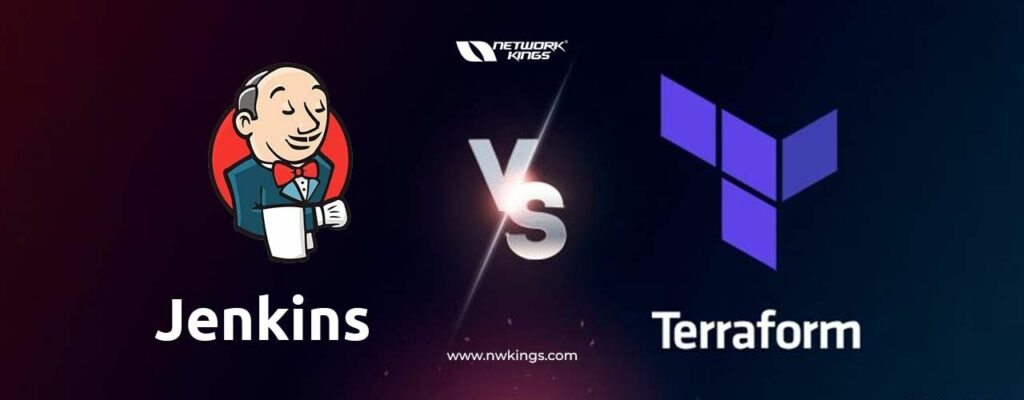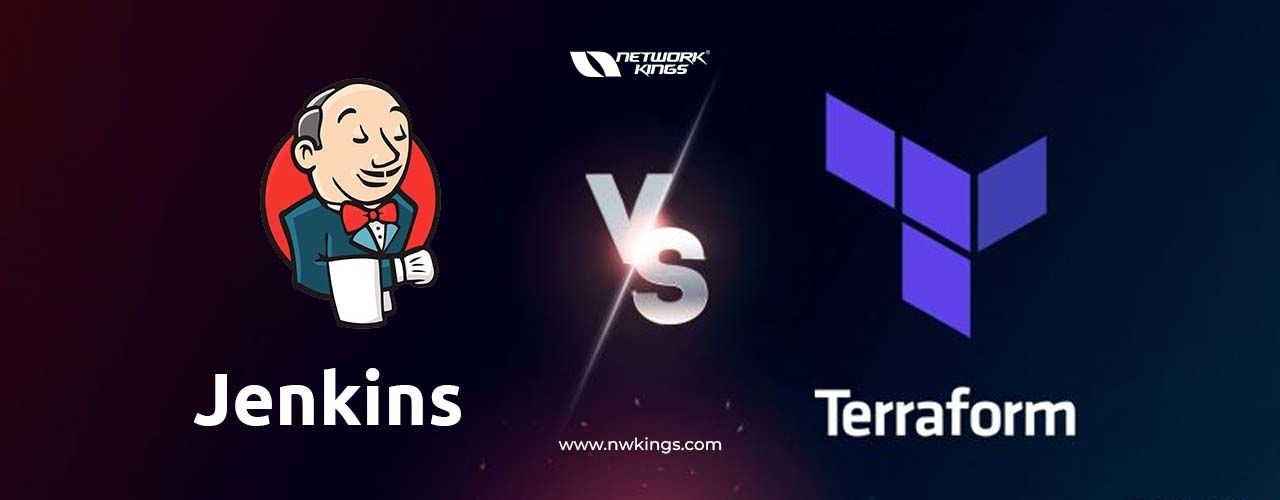
Jenkins Vs Terraform – Which is better? Know the worth of both of these tools in this blog. In the world of DevOps, choosing the right tools is crucial for the success of any team. Two popular tools that are often used in DevOps processes are Jenkins and Terraform. Jenkins is an open-source automation server that helps with continuous integration and delivery, while Terraform is an infrastructure-as-code tool that allows for the provisioning and management of infrastructure resources. Both tools have their own unique features and benefits, and understanding their roles in the DevOps process is essential for making the right choice.
Understanding the Role of Jenkins in DevOps
Jenkins is a widely used automation server that helps with the continuous integration and delivery of software. It allows developers to automate the building, testing, and deployment of their applications, making it an essential tool in the DevOps process. Jenkins integrates with various version control systems, such as Git, and can be configured to automatically trigger builds whenever changes are made to the code repository.
One of the key benefits of using Jenkins in DevOps is its ability to automate repetitive tasks, saving time and effort for developers. It provides a user-friendly interface that allows for easy configuration and management of build pipelines. Jenkins also has a vast plugin ecosystem, which allows for easy integration with other tools and technologies. This flexibility makes Jenkins a popular choice among DevOps teams.
Understanding the Role of Terraform in DevOps
Terraform is an infrastructure as a code tool that allows for the provisioning and management of infrastructure resources. It enables developers to define their infrastructure requirements using a declarative language, which can then be version-controlled and shared with the team. Terraform supports multiple cloud providers, such as AWS, Azure, and Google Cloud, making it a versatile tool for managing infrastructure across different environments.
Terraform fits into the DevOps process by providing a way to automate the creation and management of infrastructure resources. It allows for the definition of infrastructure as code, which means that infrastructure configurations can be treated as code and managed using version control systems. This ensures that infrastructure changes are tracked and can be easily rolled back if needed. Terraform also supports automation and orchestration, allowing for the creation of complex infrastructure setups with ease.
Key Features of Jenkins for DevOps Teams
- 1. Continuous integration and delivery: Jenkins provides a platform for automating the building, testing, and deployment of software. It allows for the continuous integration of code changes, ensuring that any issues are caught early in the development process. Jenkins also supports continuous delivery, allowing for the automated deployment of applications to various environments.
- 2. Plugin ecosystem: Jenkins has a vast plugin ecosystem that allows for easy integration with other tools and technologies. This makes it highly flexible and customizable, allowing teams to tailor their Jenkins setup to their specific needs. The plugin ecosystem also ensures that Jenkins can support a wide range of use cases and workflows.
- 3. Scalability and flexibility: Jenkins is highly scalable and can support large-scale deployments. It can be easily configured to distribute workloads across multiple nodes, allowing for parallel execution of builds and tests. Jenkins also supports distributed builds, which means that teams can leverage multiple machines to speed up the build process.
- 4. User-friendly interface: Jenkins provides a user-friendly web interface that allows for easy configuration and management of build pipelines. It provides a visual representation of the build process, making it easy to track the progress of builds and identify any issues. The interface also allows for easy access to build logs and reports, making troubleshooting and debugging easier.
Key Features of Terraform for DevOps Teams
1. Infrastructure as code: Terraform allows for the definition of infrastructure configurations using a declarative language. This means that infrastructure resources can be treated as code and managed using version control systems. Infrastructure changes can be tracked, reviewed, and rolled back if needed, ensuring consistency and reproducibility.
2. Multi-cloud support: Terraform supports multiple cloud providers, such as AWS, Azure, and Google Cloud. This allows teams to manage their infrastructure resources across different environments using a single tool. Terraform provides a consistent interface for provisioning and managing resources, regardless of the underlying cloud provider.
3. Version control: Terraform configurations can be version controlled using tools like Git. This allows teams to track changes to their infrastructure configurations over time and collaborate on infrastructure changes. Version control also provides a way to roll back changes if needed, ensuring that infrastructure changes can be easily managed and audited.
4. Automation and orchestration: Terraform allows for the automation and orchestration of infrastructure resources. It provides a way to define complex infrastructure setups using simple and declarative language. Terraform can also be integrated with other tools and technologies, such as Jenkins, to enable end-to-end automation of the DevOps process.
Pros and Cons of Jenkins for DevOps Teams
Advantages of using Jenkins:
- Jenkins is an open-source tool, which means it is free to use and has a large community of users and contributors.
- Jenkins has a vast plugin ecosystem, which allows for easy integration with other tools and technologies.
- Jenkins provides a user-friendly interface that makes it easy to configure and manage build pipelines.
- Jenkins supports continuous integration and delivery, allowing for the automation of the build and deployment process.
Disadvantages of using Jenkins:
- Jenkins can be resource-intensive, especially for large-scale deployments.
- Jenkins can be complex to set up and configure, especially for teams new to the tool.
- Jenkins does not provide native support for infrastructure provisioning and management.
Pros and Cons of Terraform for DevOps Teams
Advantages of using Terraform:
- Terraform allows for the definition of infrastructure as code, ensuring consistency and reproducibility.
- Terraform supports multiple cloud providers, making it a versatile tool for managing infrastructure across different environments.
- Terraform configurations can be version controlled, allowing for easy tracking and management of infrastructure changes.
- Terraform provides automation and orchestration capabilities, allowing for the creation of complex infrastructure setups.
Disadvantages of using Terraform:
- Terraform has a steeper learning curve compared to other infrastructure provisioning tools.
- Terraform may not be suitable for small-scale deployments or simple infrastructure setups.
- Terraform does not provide native support for continuous integration and delivery.
Comparison of Jenkins vs Terraform for DevOps Teams
When comparing Jenkins and Terraform, it is important to consider the specific needs and requirements of your DevOps team. Both tools have their own unique features and benefits, and choosing the right tool depends on the specific use case.
In terms of continuous integration and delivery, Jenkins is the clear winner. It provides a platform for automating the build and deployment process, and its plugin ecosystem allows for easy integration with other tools and technologies. Jenkins also has a user-friendly interface that makes it easy to configure and manage build pipelines.
On the other hand, Terraform excels in infrastructure provisioning and management. It allows for the definition of infrastructure as code, ensuring consistency and reproducibility. Terraform also supports multiple cloud providers, making it a versatile tool for managing infrastructure across different environments. However, Terraform does not provide native support for continuous integration and delivery, so teams that require this functionality may need to integrate Terraform with other tools like Jenkins.
Use Cases for Jenkins and Terraform in DevOps
Jenkins and Terraform are both widely used in the DevOps world, and they have their own specific use cases.
Jenkins is commonly used for continuous integration and delivery. It is often used to automate the build, test, and deployment process of software applications. Jenkins can be integrated with version control systems like Git to automatically trigger builds whenever changes are made to the code repository. Jenkins is also highly customizable, thanks to its plugin ecosystem, allowing teams to tailor their Jenkins setup to their specific needs.
Terraform, on the other hand, is commonly used for infrastructure provisioning and management. It allows teams to define their infrastructure requirements using a declarative language, which can then be version-controlled and shared with the team. Terraform supports multiple cloud providers, making it a versatile tool for managing infrastructure across different environments. Terraform also provides automation and orchestration capabilities, allowing for the creation of complex infrastructure setups.
Conclusion: Jenkins VS Terraform - Choosing the Right Tool for Your DevOps Team
Choosing the right tool for your DevOps team depends on your specific needs and requirements. Both Jenkins and Terraform have their own unique features and benefits, and understanding their roles in the DevOps process is essential for making the right choice.
If your team focuses on continuous integration and delivery, Jenkins is the tool of choice. It provides a platform for automating the build and deployment process, and its plugin ecosystem allows for easy integration with other tools and technologies. Jenkins also has a user-friendly interface that makes it easy to configure and manage build pipelines.
On the other hand, if your team focuses on infrastructure provisioning and management, Terraform is the tool of choice. It allows for the definition of infrastructure as code, ensuring consistency and reproducibility. Terraform supports multiple cloud providers, making it a versatile tool for managing infrastructure across different environments. However, teams that require continuous integration and delivery functionality may need to integrate Terraform with other tools like Jenkins.
In conclusion, both Jenkins Vs Terraform are powerful tools that can greatly enhance the DevOps process. Understanding their roles and features is essential for making the right choice for your specific needs. Whether you choose Jenkins or Terraform, both tools have proven to be valuable assets for DevOps teams around the world.


